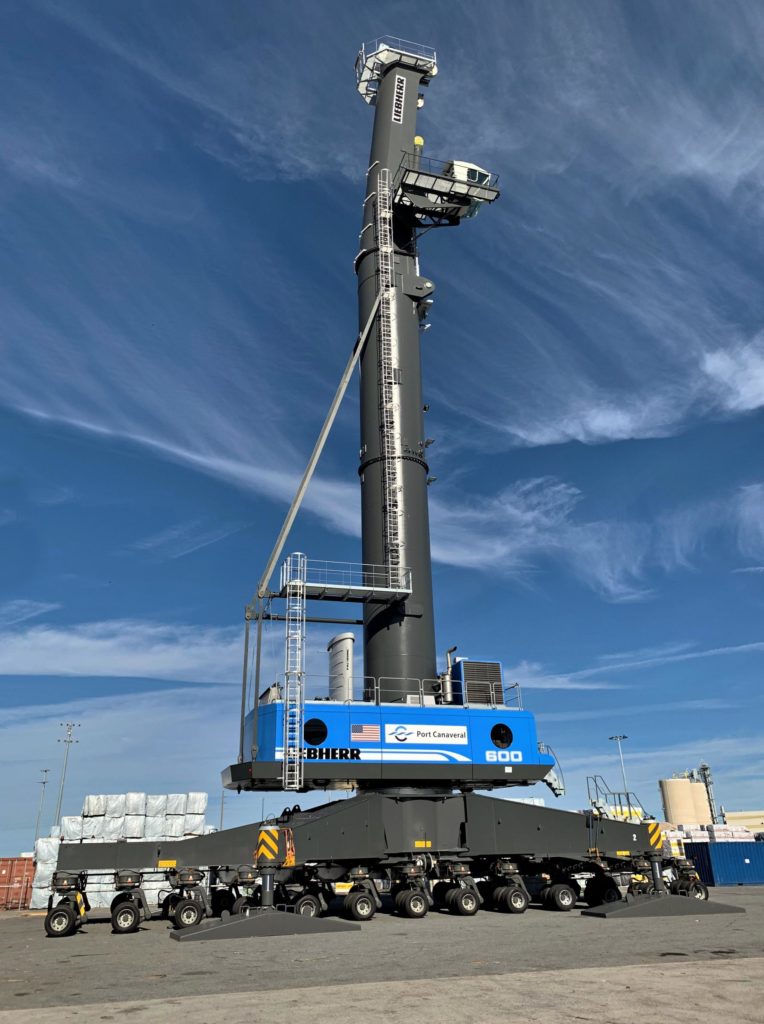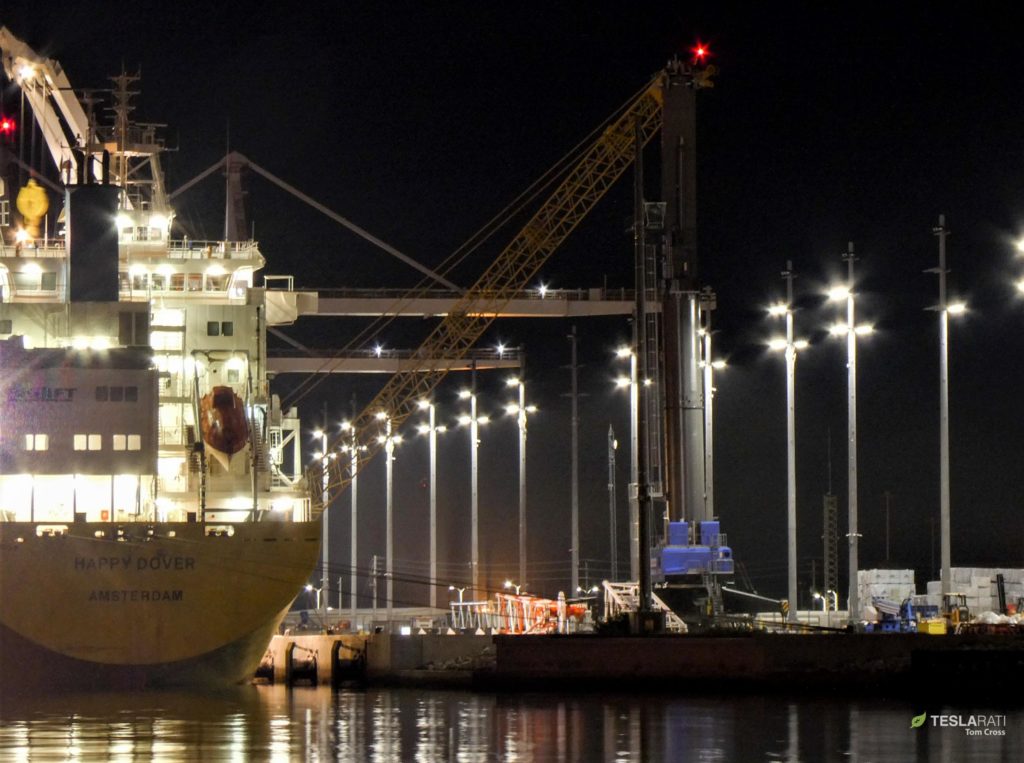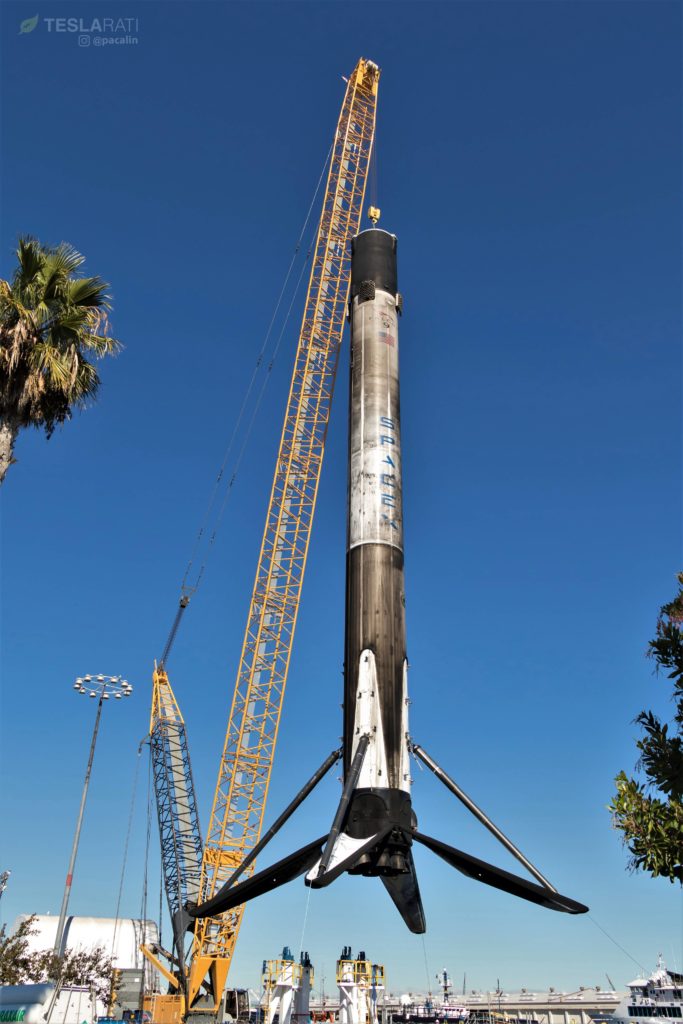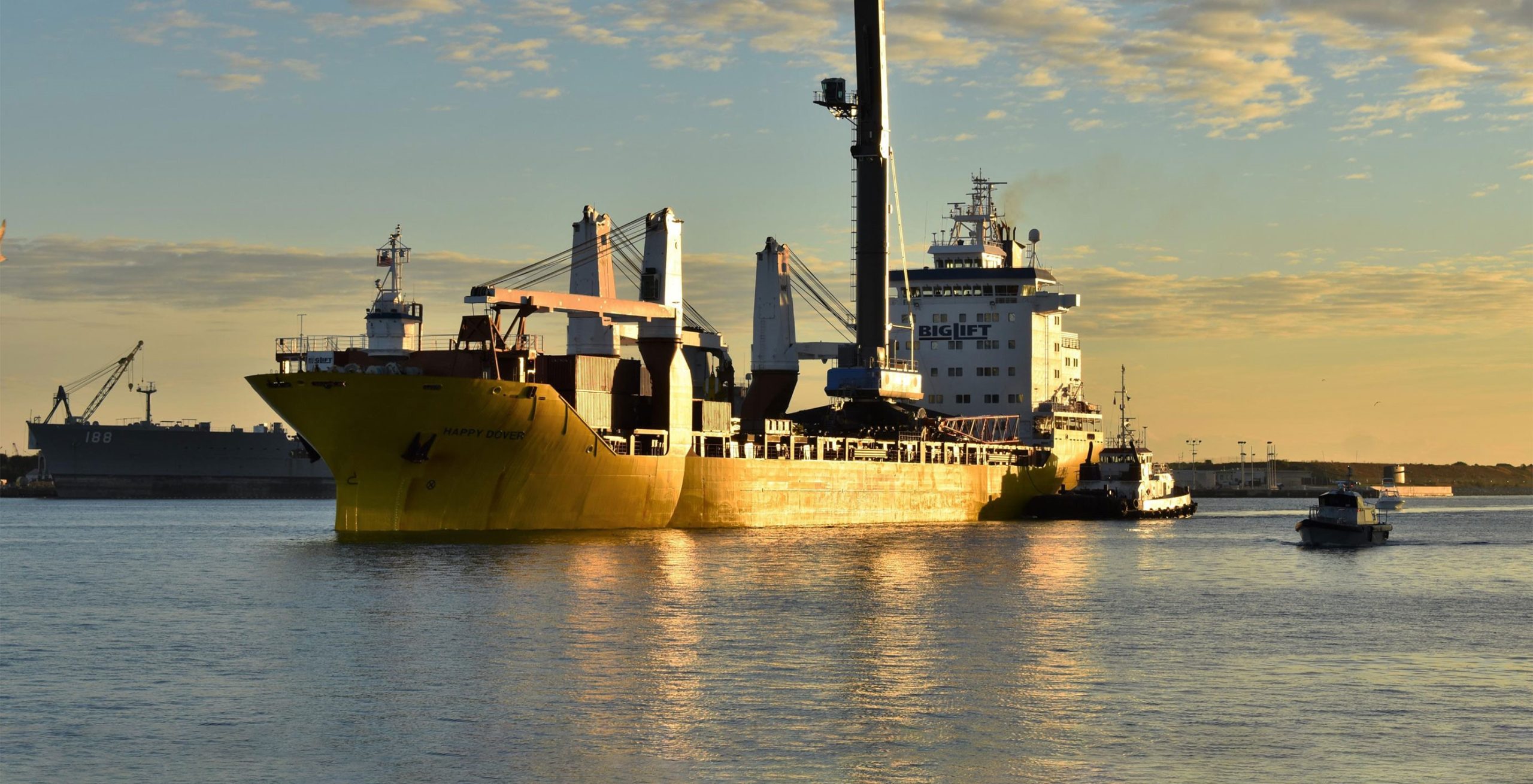
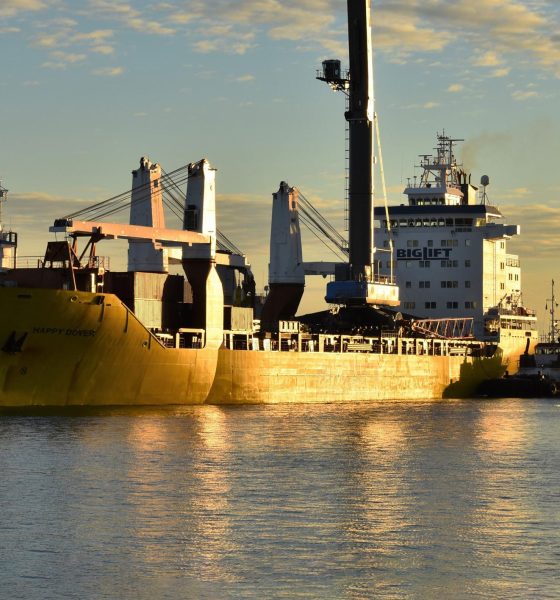
News
Future SpaceX & Blue Origin rocket recoveries may use largest mobile crane in the US
Florida’s Canaveral Port Authority took delivery of what is now the largest mobile crane on U.S. soil, originally purchased in order to support both extremely large cargo ships (known as New-Panamax-class) and the unique needs of orbital-class rocket recovery operations for SpaceX’s Falcon 9 and Falcon Heavy and Blue Origin’s prospective New Glenn launch vehicle.
While there’s a good chance that SpaceX will avoid changing their current Port Canaveral recovery operations and the complement of cranes they already lease or own, Blue Origin will almost certainly take advantage of Port Canaveral’s vast new crane, capable of lifting more than 200 metric tons (~450,000 lbs) at heights greater than 50 meters (160 ft).
I know @AstroVicnet had some questions about the new mobile crane and how it will be used in Port Canaveral. Here is an explainer and how it connects to our Spaceport partners like @SpaceX and @blueorigin. #SpaceXFleet https://t.co/UQqItZbdIr
— Julia Bergeron (@julia_bergeron) January 19, 2019
To put the scale of the crane (and perhaps SpaceX and Blue Origin rockets) into perspective, Falcon 9’s booster – on its own – stands an incredibly 45m (~150 ft) tall or almost the same height as the LHM 600’s main boom (the gray cylinder/tower in the photos above), while Blue Origin’s New Glenn first stage – set to debut as early as 2021 – would tower an extraordinary 57.5m (~190 ft) tall, probably 60m if its small legs are deployed. While SpaceX’s BFR booster (now Super Heavy) is expected to attempt recoveries on the actual launch pad mount, it would stand around 63m (~210 ft) tall. New Glenn and Super Heavy are likely to weigh 50-150+ tons empty.
COLOSSAL CRANE ARRIVES: A 270-foot-tall mobile harbor crane billed as the largest in the United States sails into Port Canaveral aboard the cargo vessel Happy Dover on Friday morning. The 87-foot-long, 1.1-million-pound Liebherr LHM 600 is set to go into service later this year. pic.twitter.com/51DP8Hdb0w
— Port Canaveral (@PortCanaveral) January 18, 2019
The point is that for monolithic objects that are as tall as large rocket boosters, the logistics of actually moving them around can be surprisingly complex and challenging. SpaceX’s Falcon 9 and Heavy boosters happen to be short enough to be conveniently moved and manipulated by cranes that are quite large but still fairly common and easy enough to lease or purchase. SpaceX consistently uses similar tall, yellow cranes for the process of actually lifting Falcon 9 boosters – around 30t (~66,000 lbs) dry – off of their drone ships and onto land, while far smaller wheeled cranes can be used for the process of manipulating Falcon boosters once they are horizontal.
Given just how relatively light Falcon boosters are compared to their towering height, the cranes that can safely lift such tall and delicate objects tend to be designed to easily lift 5-10X as much weight at once. The next-generation rocket boosters (and even SpaceX’s Starship upper stage) will continue to push the height performance and begin to test the mass capabilities of modern cranes, particularly mobile varieties like the one that just arrived in Port Canaveral. One massive benefit of wheeled cranes like LHM 600 is how versatile and flexible they are, while tracked cranes like the largest ones SpaceX currently uses simply can’t move without risking the destruction of the ground beneath them, requiring that they use advanced mass-spreading technologies (i.e. giant beams of hardwood) wherever they crawl.
- Another view of Port Canaveral’s shiny new LHM 600 crane shortly after arriving ashore. (Canaveral Port Authority)
- Teslarati photographer Tom Cross managed to catch Port Canaveral’s new crane shortly after sunset, January 18th. (Tom Cross)
- One of several large cranes used by SpaceX to vertically transport Falcon 9 and Falcon Heavy boosters is pictured here during third recovery of Falcon 9 B1046, December 2018. (Pauline Acalin)
- New Glenn is a massive reusable rocket that will stand ~82m (270 ft) tall and be able to launch up to 45 metric tons (100,000 lb) to low Earth orbit (LEO). (Blue Origin)
Liebherr’s mobile harbor cranes offer a far more mobile solution in the form of traditional rubber tires and multiple large spreader plates that can be deployed and retracted when stationary. It will be genuinely interesting to see if SpaceX decides to replace its proven modes of vertical-lift recovery operations to gain the benefits of a crane that is new and an unknown quantity but could still simplify certain recovery operations. Perhaps even more importantly, the Canaveral Port Authority owns the new crane and apparently bought it with the specific intention of allowing companies like SpaceX and Blue Origin to use it – presumably for a reasonable fee – to assist during rocket recovery operations.

Elon Musk
Elon Musk and Tesla AI Director share insights after empty driver seat Robotaxi rides
The executives’ unoccupied tests hint at the rapid progress of Tesla’s unsupervised Robotaxi efforts.

Tesla CEO Elon Musk and AI Director Ashok Elluswamy celebrated Christmas Eve by sharing personal experiences with Robotaxi vehicles that had no safety monitor or occupant in the driver’s seat. Musk described the system’s “perfect driving” around Austin, while Elluswamy posted video from the back seat, calling it “an amazing experience.”
The executives’ unoccupied tests hint at the rapid progress of Tesla’s unsupervised Robotaxi efforts.
Elon and Ashok’s firsthand Robotaxi insights
Prior to Musk and the Tesla AI Director’s posts, sightings of unmanned Teslas navigating public roads were widely shared on social media. One such vehicle was spotted in Austin, Texas, which Elon Musk acknowleged by stating that “Testing is underway with no occupants in the car.”
Based on his Christmas Eve post, Musk seemed to have tested an unmanned Tesla himself. “A Tesla with no safety monitor in the car and me sitting in the passenger seat took me all around Austin on Sunday with perfect driving,” Musk wrote in his post.
Elluswamy responded with a 2-minute video showing himself in the rear of an unmanned Tesla. The video featured the vehicle’s empty front seats, as well as its smooth handling through real-world traffic. He captioned his video with the words, “It’s an amazing experience!”
Towards Unsupervised operations
During an xAI Hackathon earlier this month, Elon Musk mentioned that Tesla owed be removing Safety Monitors from its Robotaxis in Austin in just three weeks. “Unsupervised is pretty much solved at this point. So there will be Tesla Robotaxis operating in Austin with no one in them. Not even anyone in the passenger seat in about three weeks,” he said. Musk echoed similar estimates at the 2025 Annual Shareholder Meeting and the Q3 2025 earnings call.
Considering the insights that were posted Musk and Elluswamy, it does appear that Tesla is working hard towards operating its Robotaxis with no safety monitors. This is quite impressive considering that the service was launched just earlier this year.
Elon Musk
Starlink passes 9 million active customers just weeks after hitting 8 million
The milestone highlights the accelerating growth of Starlink, which has now been adding over 20,000 new users per day.

SpaceX’s Starlink satellite internet service has continued its rapid global expansion, surpassing 9 million active customers just weeks after crossing the 8 million mark.
The milestone highlights the accelerating growth of Starlink, which has now been adding over 20,000 new users per day.
9 million customers
In a post on X, SpaceX stated that Starlink now serves over 9 million active users across 155 countries, territories, and markets. The company reached 8 million customers in early November, meaning it added roughly 1 million subscribers in under seven weeks, or about 21,275 new users on average per day.
“Starlink is connecting more than 9M active customers with high-speed internet across 155 countries, territories, and many other markets,” Starlink wrote in a post on its official X account. SpaceX President Gwynne Shotwell also celebrated the milestone on X. “A huge thank you to all of our customers and congrats to the Starlink team for such an incredible product,” she wrote.
That growth rate reflects both rising demand for broadband in underserved regions and Starlink’s expanding satellite constellation, which now includes more than 9,000 low-Earth-orbit satellites designed to deliver high-speed, low-latency internet worldwide.
Starlink’s momentum
Starlink’s momentum has been building up. SpaceX reported 4.6 million Starlink customers in December 2024, followed by 7 million by August 2025, and 8 million customers in November. Independent data also suggests Starlink usage is rising sharply, with Cloudflare reporting that global web traffic from Starlink users more than doubled in 2025, as noted in an Insider report.
Starlink’s momentum is increasingly tied to SpaceX’s broader financial outlook. Elon Musk has said the satellite network is “by far” the company’s largest revenue driver, and reports suggest SpaceX may be positioning itself for an initial public offering as soon as next year, with valuations estimated as high as $1.5 trillion. Musk has also suggested in the past that Starlink could have its own IPO in the future.
News
NVIDIA Director of Robotics: Tesla FSD v14 is the first AI to pass the “Physical Turing Test”
After testing FSD v14, Fan stated that his experience with FSD felt magical at first, but it soon started to feel like a routine.

NVIDIA Director of Robotics Jim Fan has praised Tesla’s Full Self-Driving (Supervised) v14 as the first AI to pass what he described as a “Physical Turing Test.”
After testing FSD v14, Fan stated that his experience with FSD felt magical at first, but it soon started to feel like a routine. And just like smartphones today, removing it now would “actively hurt.”
Jim Fan’s hands-on FSD v14 impressions
Fan, a leading researcher in embodied AI who is currently solving Physical AI at NVIDIA and spearheading the company’s Project GR00T initiative, noted that he actually was late to the Tesla game. He was, however, one of the first to try out FSD v14.
“I was very late to own a Tesla but among the earliest to try out FSD v14. It’s perhaps the first time I experience an AI that passes the Physical Turing Test: after a long day at work, you press a button, lay back, and couldn’t tell if a neural net or a human drove you home,” Fan wrote in a post on X.
Fan added: “Despite knowing exactly how robot learning works, I still find it magical watching the steering wheel turn by itself. First it feels surreal, next it becomes routine. Then, like the smartphone, taking it away actively hurts. This is how humanity gets rewired and glued to god-like technologies.”
The Physical Turing Test
The original Turing Test was conceived by Alan Turing in 1950, and it was aimed at determining if a machine could exhibit behavior that is equivalent to or indistinguishable from a human. By focusing on text-based conversations, the original Turing Test set a high bar for natural language processing and machine learning.
This test has been passed by today’s large language models. However, the capability to converse in a humanlike manner is a completely different challenge from performing real-world problem-solving or physical interactions. Thus, Fan introduced the Physical Turing Test, which challenges AI systems to demonstrate intelligence through physical actions.
Based on Fan’s comments, Tesla has demonstrated these intelligent physical actions with FSD v14. Elon Musk agreed with the NVIDIA executive, stating in a post on X that with FSD v14, “you can sense the sentience maturing.” Musk also praised Tesla AI, calling it the best “real-world AI” today.
